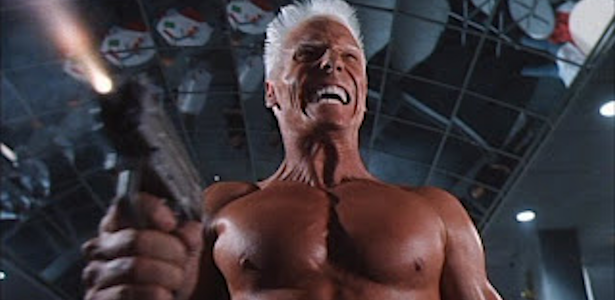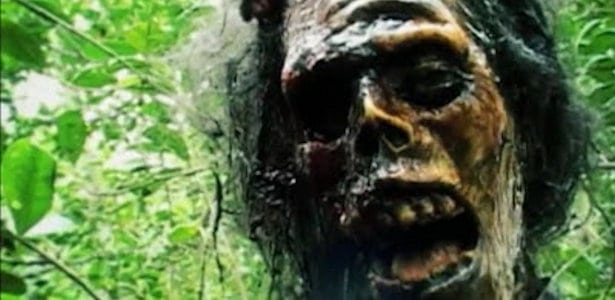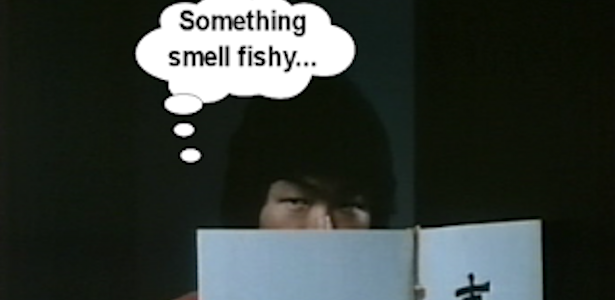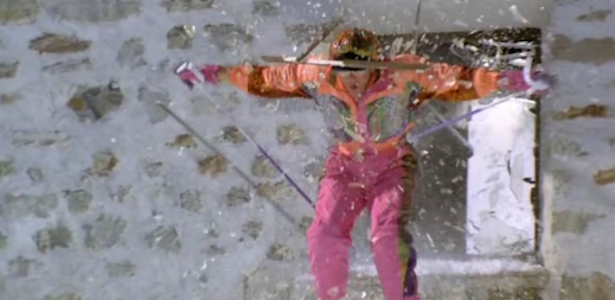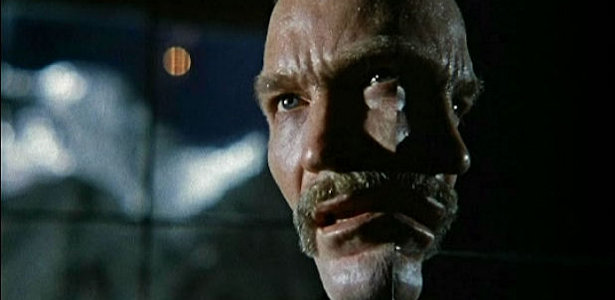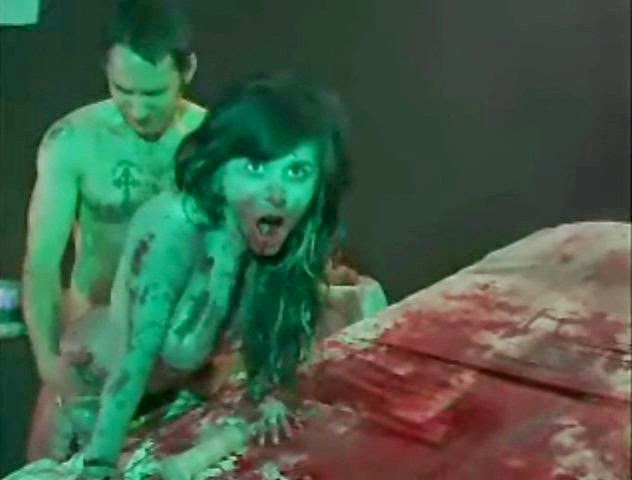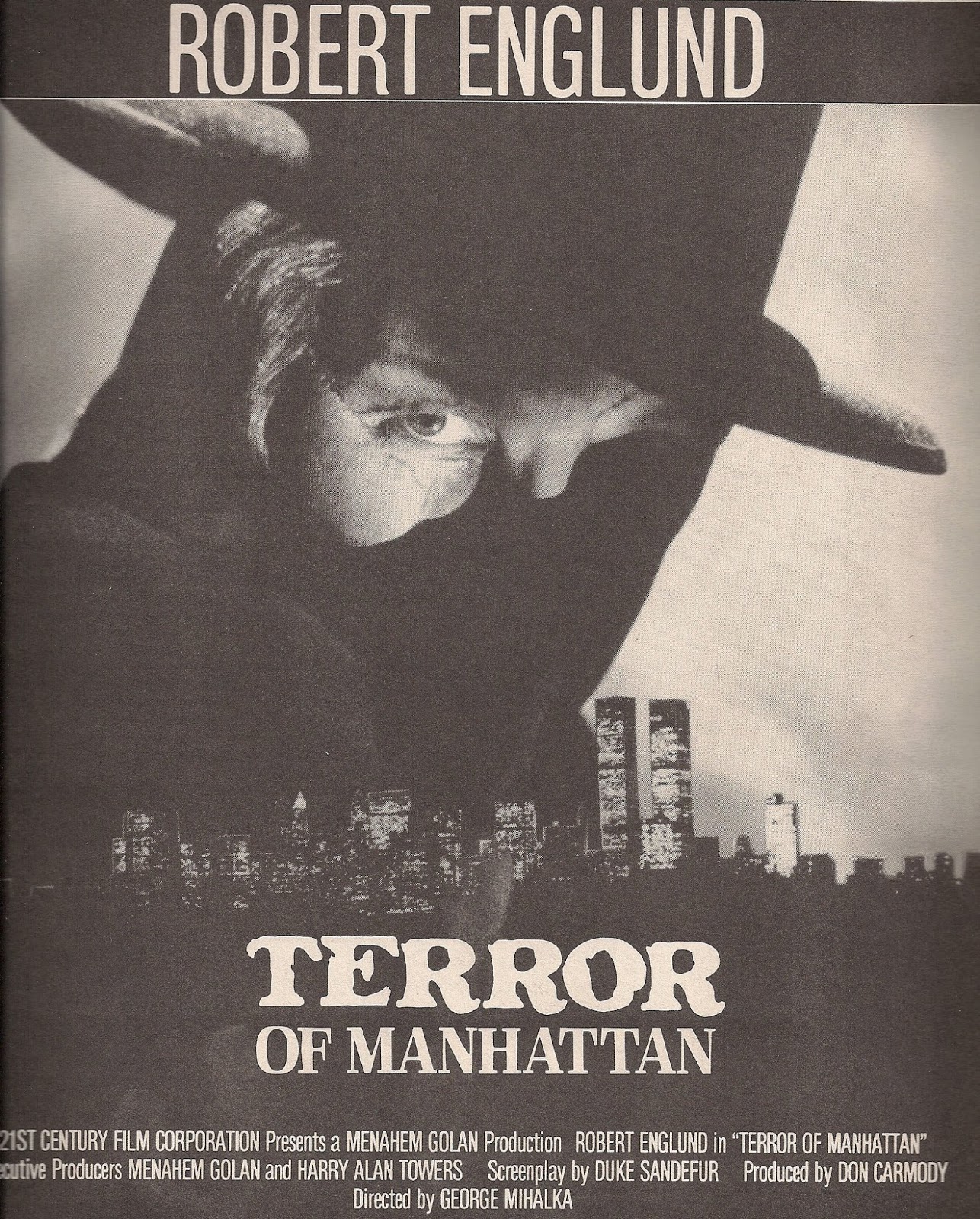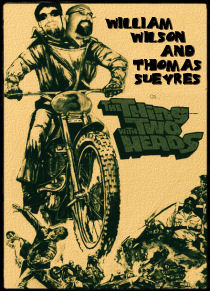If you were around in the '70s and '80s, you will have owned at least on record on the Scotti Bros label. While Tony and Ben Scotti were responsible for launching such luminous careers as Leif Garrett and Weird Al Yankovic, it was the theme song for ROCKY III (1982) that blew the lid off of the label. Survivor's "The Eye of the Tiger" was the number one single in the US and the UK and even if you weren't around in the '80s, you have heard this song. Probably even karaoked it, if you wear a vest with a v-neck undershirt.
Tony Scotti started out as a small time actor in TV and film and Ben Scotti was at one time a defensive back for in the NFL with the Redskins, Eagles and Niners. They started up their record label in 1974, but in the '80s they moved into movie production and distribution.
Their first film in 1986 was an entertaining Gary Busey action vehicle named (what else?) THE EYE OF THE TIGER for which they tapped the talents of director Richard C. Sarafian. The company was only involved with a handful of movies and sadly most of them are not Video Junkie material. Sorry, you will never see a review of HE'S MY GIRL (1987) no matter how much we like T.J. Carter. Their final film was unequivocally their finest hour and a half, an adaptation of the H.P. Lovecraft story "The Case of Charles Dexter Ward."
 Told in a non-linear fashion, I will try to keep the spoilers to a minimum, but really if you haven't seen the movie. You need to do that. Now. I'll wait.
Told in a non-linear fashion, I will try to keep the spoilers to a minimum, but really if you haven't seen the movie. You need to do that. Now. I'll wait.
Opening the way all horror movies should open, with a dark and stormy night, Charles Dexter Ward has escaped from an asylum leaving a bloody mess of human carnage and a large, black scorch-mark. How this came to be is told in flashback by private investigator John Marsh (John Terry). After the cosmetics executive, Ward, goes missing, his wife Claire Ward (Jane Sibbett), hires gumshoe March to investigate his disappearance and his bizarre research that may be linked to the occult. The police are investigating as well and want to know why they found a suitcase of human remains in the boathouse that he was using as a laboratory.
In short order, March discovers that Ward is using a farmhouse in Rhode Island's Pawtuxet Valley, with a man named Dr. Ash, that has been the site of strange nocturnal deliveries and noxious odors. He also discovers that one of those deliveries was witnessed by a neighbor to be eight coffins, and coincides with the recent robbery of eight graves of ancient European practitioners of the occult.

While conducting his investigation, Claire finally tells March about a trunk Ward had received from a dead relative that he never knew. It contained strange papers from the 1700s discussing dark experiments. Yeah, I know that's awfully vague, but I can't ruin the movie if you ignored my orders a few paragraphs ago.
Directed by Dan O'Bannon from a screenplay by Brent V. Friedman, who was fresh off of the brilliant low-rent sequel to William Malone's SCARED TO DEATH (1980), titled SYNGENOR (1990), this is probably the best Lovecraft adaptation you will ever see. Sure it's a slightly budget starved (some of the effects are a little lacking), but O'Bannon's direction is impeccable, with a prowling camera that feels at times like an old Argento film. Besides, if you get nostril-deep in Lovecraft adaptations this $6 million production will feel more extravagant than the latest Marvel adaptation.
 As always, I feel like I have to defend the changes made in the film. Yes, it is Ward's father who has him committed in the story, and yes, there is no Detective Marsh or Mrs. Ward in the story either. I supposed you could have a narrated film without those characters, but it would be clumsy and annoying as the story is simply a third-person accounting of a history of one man. Those new characters have to exist to drive the narrative forward in the structure of a film. Not only is it necessary to bring in those characters, but I really like the idea of fusing a bit of Phillip Marlowe / Mike Hammer in the Lovecraftian milieu. Additionally, the film contains as many horror trappings as you could possibly ask for including lightning storms, fire, fog, an insane asylum, creepy paintings, a secret library, dark cellars, putrid tunnels, bloody corpses, human experiments, ancient apocryphal texts, and a dark family secret. Really, what more could you ask for?
As always, I feel like I have to defend the changes made in the film. Yes, it is Ward's father who has him committed in the story, and yes, there is no Detective Marsh or Mrs. Ward in the story either. I supposed you could have a narrated film without those characters, but it would be clumsy and annoying as the story is simply a third-person accounting of a history of one man. Those new characters have to exist to drive the narrative forward in the structure of a film. Not only is it necessary to bring in those characters, but I really like the idea of fusing a bit of Phillip Marlowe / Mike Hammer in the Lovecraftian milieu. Additionally, the film contains as many horror trappings as you could possibly ask for including lightning storms, fire, fog, an insane asylum, creepy paintings, a secret library, dark cellars, putrid tunnels, bloody corpses, human experiments, ancient apocryphal texts, and a dark family secret. Really, what more could you ask for?
 As much as I like the idea, John Terry, who you may remember from HAWK THE SLAYER (1980), TUXEDO WARRIOR (1982) and even as Felix Leiter in THE LIVING DAYLIGHTS (1987), isn't really the best leading man. Unless you live in Hawaii and drive a red Ferrari 308, a private investigator should be like his office: Shabby and rundown. Here Terry is rather realistic, wearing a crisp suit in a fashionable modern office, and playing the part accordingly. If you didn't know better he could be playing a lawyer. Also Jane Sibbett is a dyed in the wool TV actress if ever there was one. Her performance is so flat she appears to be a walking advertisement for botox. I get that she's supposed to be taking her queues from hard-boiled beauties like Veronica Lake and Lauren Bacall, but she lacks the sultry sparkle that gives their characters dimension.
As much as I like the idea, John Terry, who you may remember from HAWK THE SLAYER (1980), TUXEDO WARRIOR (1982) and even as Felix Leiter in THE LIVING DAYLIGHTS (1987), isn't really the best leading man. Unless you live in Hawaii and drive a red Ferrari 308, a private investigator should be like his office: Shabby and rundown. Here Terry is rather realistic, wearing a crisp suit in a fashionable modern office, and playing the part accordingly. If you didn't know better he could be playing a lawyer. Also Jane Sibbett is a dyed in the wool TV actress if ever there was one. Her performance is so flat she appears to be a walking advertisement for botox. I get that she's supposed to be taking her queues from hard-boiled beauties like Veronica Lake and Lauren Bacall, but she lacks the sultry sparkle that gives their characters dimension.
 On the other hand, Chris Sarandon is an actor I was never really impressed with until 1985 with the release of FRIGHT NIGHT (1985). Even moreso, THE RESURRECTED is arguably the finest performance of his career with his portrayal of the older, affected Ward. Clearly he took this role very seriously and puts real effort into playing a crazed older man, speaking as though he were from the 1700s. His performance is so dead perfect that his face instantly comes to mind when I see the name Charles Dexter Ward, much like it is inescapable of thinking about Jeffrey Combs when you see the name Herbert West. Going up against this is part of the reason that Terry and Sibbett don't come off as well as they might have. Ward is a much meatier role that allows Sarandon to flex his acting chops in a way that he never was able to before.
On the other hand, Chris Sarandon is an actor I was never really impressed with until 1985 with the release of FRIGHT NIGHT (1985). Even moreso, THE RESURRECTED is arguably the finest performance of his career with his portrayal of the older, affected Ward. Clearly he took this role very seriously and puts real effort into playing a crazed older man, speaking as though he were from the 1700s. His performance is so dead perfect that his face instantly comes to mind when I see the name Charles Dexter Ward, much like it is inescapable of thinking about Jeffrey Combs when you see the name Herbert West. Going up against this is part of the reason that Terry and Sibbett don't come off as well as they might have. Ward is a much meatier role that allows Sarandon to flex his acting chops in a way that he never was able to before.
Aside from minor acting quibbles, and maybe a few rubbery-looking effects, this is without question the finest Lovecraft adaptation on celluloid. It's a shame that it has been such a sleeper film, but then again, at least hipsters haven't ruined it for the rest of us.
Tony Scotti started out as a small time actor in TV and film and Ben Scotti was at one time a defensive back for in the NFL with the Redskins, Eagles and Niners. They started up their record label in 1974, but in the '80s they moved into movie production and distribution.
Their first film in 1986 was an entertaining Gary Busey action vehicle named (what else?) THE EYE OF THE TIGER for which they tapped the talents of director Richard C. Sarafian. The company was only involved with a handful of movies and sadly most of them are not Video Junkie material. Sorry, you will never see a review of HE'S MY GIRL (1987) no matter how much we like T.J. Carter. Their final film was unequivocally their finest hour and a half, an adaptation of the H.P. Lovecraft story "The Case of Charles Dexter Ward."
 Told in a non-linear fashion, I will try to keep the spoilers to a minimum, but really if you haven't seen the movie. You need to do that. Now. I'll wait.
Told in a non-linear fashion, I will try to keep the spoilers to a minimum, but really if you haven't seen the movie. You need to do that. Now. I'll wait.Opening the way all horror movies should open, with a dark and stormy night, Charles Dexter Ward has escaped from an asylum leaving a bloody mess of human carnage and a large, black scorch-mark. How this came to be is told in flashback by private investigator John Marsh (John Terry). After the cosmetics executive, Ward, goes missing, his wife Claire Ward (Jane Sibbett), hires gumshoe March to investigate his disappearance and his bizarre research that may be linked to the occult. The police are investigating as well and want to know why they found a suitcase of human remains in the boathouse that he was using as a laboratory.
In short order, March discovers that Ward is using a farmhouse in Rhode Island's Pawtuxet Valley, with a man named Dr. Ash, that has been the site of strange nocturnal deliveries and noxious odors. He also discovers that one of those deliveries was witnessed by a neighbor to be eight coffins, and coincides with the recent robbery of eight graves of ancient European practitioners of the occult.

While conducting his investigation, Claire finally tells March about a trunk Ward had received from a dead relative that he never knew. It contained strange papers from the 1700s discussing dark experiments. Yeah, I know that's awfully vague, but I can't ruin the movie if you ignored my orders a few paragraphs ago.
Directed by Dan O'Bannon from a screenplay by Brent V. Friedman, who was fresh off of the brilliant low-rent sequel to William Malone's SCARED TO DEATH (1980), titled SYNGENOR (1990), this is probably the best Lovecraft adaptation you will ever see. Sure it's a slightly budget starved (some of the effects are a little lacking), but O'Bannon's direction is impeccable, with a prowling camera that feels at times like an old Argento film. Besides, if you get nostril-deep in Lovecraft adaptations this $6 million production will feel more extravagant than the latest Marvel adaptation.
 As always, I feel like I have to defend the changes made in the film. Yes, it is Ward's father who has him committed in the story, and yes, there is no Detective Marsh or Mrs. Ward in the story either. I supposed you could have a narrated film without those characters, but it would be clumsy and annoying as the story is simply a third-person accounting of a history of one man. Those new characters have to exist to drive the narrative forward in the structure of a film. Not only is it necessary to bring in those characters, but I really like the idea of fusing a bit of Phillip Marlowe / Mike Hammer in the Lovecraftian milieu. Additionally, the film contains as many horror trappings as you could possibly ask for including lightning storms, fire, fog, an insane asylum, creepy paintings, a secret library, dark cellars, putrid tunnels, bloody corpses, human experiments, ancient apocryphal texts, and a dark family secret. Really, what more could you ask for?
As always, I feel like I have to defend the changes made in the film. Yes, it is Ward's father who has him committed in the story, and yes, there is no Detective Marsh or Mrs. Ward in the story either. I supposed you could have a narrated film without those characters, but it would be clumsy and annoying as the story is simply a third-person accounting of a history of one man. Those new characters have to exist to drive the narrative forward in the structure of a film. Not only is it necessary to bring in those characters, but I really like the idea of fusing a bit of Phillip Marlowe / Mike Hammer in the Lovecraftian milieu. Additionally, the film contains as many horror trappings as you could possibly ask for including lightning storms, fire, fog, an insane asylum, creepy paintings, a secret library, dark cellars, putrid tunnels, bloody corpses, human experiments, ancient apocryphal texts, and a dark family secret. Really, what more could you ask for? As much as I like the idea, John Terry, who you may remember from HAWK THE SLAYER (1980), TUXEDO WARRIOR (1982) and even as Felix Leiter in THE LIVING DAYLIGHTS (1987), isn't really the best leading man. Unless you live in Hawaii and drive a red Ferrari 308, a private investigator should be like his office: Shabby and rundown. Here Terry is rather realistic, wearing a crisp suit in a fashionable modern office, and playing the part accordingly. If you didn't know better he could be playing a lawyer. Also Jane Sibbett is a dyed in the wool TV actress if ever there was one. Her performance is so flat she appears to be a walking advertisement for botox. I get that she's supposed to be taking her queues from hard-boiled beauties like Veronica Lake and Lauren Bacall, but she lacks the sultry sparkle that gives their characters dimension.
As much as I like the idea, John Terry, who you may remember from HAWK THE SLAYER (1980), TUXEDO WARRIOR (1982) and even as Felix Leiter in THE LIVING DAYLIGHTS (1987), isn't really the best leading man. Unless you live in Hawaii and drive a red Ferrari 308, a private investigator should be like his office: Shabby and rundown. Here Terry is rather realistic, wearing a crisp suit in a fashionable modern office, and playing the part accordingly. If you didn't know better he could be playing a lawyer. Also Jane Sibbett is a dyed in the wool TV actress if ever there was one. Her performance is so flat she appears to be a walking advertisement for botox. I get that she's supposed to be taking her queues from hard-boiled beauties like Veronica Lake and Lauren Bacall, but she lacks the sultry sparkle that gives their characters dimension. On the other hand, Chris Sarandon is an actor I was never really impressed with until 1985 with the release of FRIGHT NIGHT (1985). Even moreso, THE RESURRECTED is arguably the finest performance of his career with his portrayal of the older, affected Ward. Clearly he took this role very seriously and puts real effort into playing a crazed older man, speaking as though he were from the 1700s. His performance is so dead perfect that his face instantly comes to mind when I see the name Charles Dexter Ward, much like it is inescapable of thinking about Jeffrey Combs when you see the name Herbert West. Going up against this is part of the reason that Terry and Sibbett don't come off as well as they might have. Ward is a much meatier role that allows Sarandon to flex his acting chops in a way that he never was able to before.
On the other hand, Chris Sarandon is an actor I was never really impressed with until 1985 with the release of FRIGHT NIGHT (1985). Even moreso, THE RESURRECTED is arguably the finest performance of his career with his portrayal of the older, affected Ward. Clearly he took this role very seriously and puts real effort into playing a crazed older man, speaking as though he were from the 1700s. His performance is so dead perfect that his face instantly comes to mind when I see the name Charles Dexter Ward, much like it is inescapable of thinking about Jeffrey Combs when you see the name Herbert West. Going up against this is part of the reason that Terry and Sibbett don't come off as well as they might have. Ward is a much meatier role that allows Sarandon to flex his acting chops in a way that he never was able to before.Aside from minor acting quibbles, and maybe a few rubbery-looking effects, this is without question the finest Lovecraft adaptation on celluloid. It's a shame that it has been such a sleeper film, but then again, at least hipsters haven't ruined it for the rest of us.




